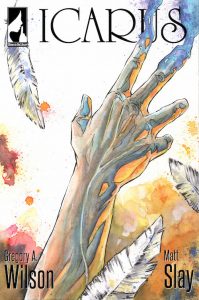Gregory Wilson Guest Post–“Creativity and Collaboration”
 Most of the time, authors are used to flying solo. Well before we start thinking about submitting work for publication, we’re scribbling in journals, writing poems mostly for ourselves, coming up with characters and places and plots for short stories and novels which we think are cool—us, not some mythical other reader who floats in the aether, ever out of reach. As we mature as writers we become more aware of our reading audience, of course; as Damon Knight says, writing for ourselves alone is Stage One writing, valuable in its own way but not really equivalent to work which is intended to convey theme and concept to other people. And even if we don’t collaborate with other authors, when we begin to submit work to agents and publishers we become aware of other people involved in the transaction of writing: the gatekeepers, slush pile readers and acquisitions editors who need to love our work as much (or more!) as we do before agreeing to publish it in publically available form. Even if we self-publish, we need to be aware of potential readers and what they might value. But none of this changes the fundamental solitary nature of creative writing in prose and poetry—we come up with the people and places and ideas, others react to and tweak and alter them.
Most of the time, authors are used to flying solo. Well before we start thinking about submitting work for publication, we’re scribbling in journals, writing poems mostly for ourselves, coming up with characters and places and plots for short stories and novels which we think are cool—us, not some mythical other reader who floats in the aether, ever out of reach. As we mature as writers we become more aware of our reading audience, of course; as Damon Knight says, writing for ourselves alone is Stage One writing, valuable in its own way but not really equivalent to work which is intended to convey theme and concept to other people. And even if we don’t collaborate with other authors, when we begin to submit work to agents and publishers we become aware of other people involved in the transaction of writing: the gatekeepers, slush pile readers and acquisitions editors who need to love our work as much (or more!) as we do before agreeing to publish it in publically available form. Even if we self-publish, we need to be aware of potential readers and what they might value. But none of this changes the fundamental solitary nature of creative writing in prose and poetry—we come up with the people and places and ideas, others react to and tweak and alter them.
In the progress of my own writing career I got very used to this solo approach. I certainly appreciated what my editors did for my work, but I still imagined myself as the initial source of the creative process—though oddly, in other aspects of my professional life as a professor, both with colleagues and students I tend to lean towards collaboration and group discussion, even a decent amount of collaborative work in my creative writing courses.
And then came Icarus. When I first developed the concept, about a young man with wings falling into the heart of a massive dormant volcano on another planet and the creatures he finds there, I thought of it in prose—though, as is often the case, the visual image (this time from a Cirque du Soleil show) was always in my mind as I was writing. And I wrote it as a novel in the usual way, on my own, with several beta readers I trusted providing feedback as I went, before submitting it to agents and publishers. It came close but didn’t get picked up, and it was on the back burner until I met Ron Garner from Silence in the Library Publishing and we began chatting about graphic novels. I had always known Icarus was a very visual story, and when Ron started describing what it could look like in visual form, I got as excited as he was.
But I had no experience in writing a graphic novel, and I assumed it was mostly just a matter of sending the book to the artist (decidedly not me!) and being ready to consult on the characters and world after that. I was… very wrong. First of all, Icarus is indeed a visual story, but that wasn’t enough on its own—I had to create a visual outline, highlighting the major visual cues and making suggestions about character appearance, set piece pictures at high points in the story, and so on. And an 84,000 word novel isn’t suitable for an (ultimately) 150 page or so graphic novel, and that meant we needed a script—which was written by Keith DeCandido, who did his usual professional job in adapting my story for use in the graphic novel medium. And space restrictions which are a reality of any visual medium in print meant additional compression, particularly in dialogue; the letterer, Kris Siuda, did tremendous work to create space to fit the dialogue which remained. And we had two artists, not just one, so both the work of Matt Slay and Mark Dos Santos went into representing the final product. And there was layout to be done, started by Glenn Haumann from Comic Mix and continued by Kris and Ron. And, and, and….
You get the idea. Icarus the novel was written by me, read by a couple of others, and (had it been published in its original prose form) edited by a couple of people after that. Icarus the graphic novel was written by me, read by a couple of others, edited by Ron, scripted by Keith, artistically rendered by Matt and Mark, lettered and color corrected by Kris, laid out by Glenn and Ron, and the list continues. It truly was a group effort, which was frankly kind of terrifying. It has my name on the cover, sure, but what happens when it’s actually the work of a lot more people than just me? Is it really mine anymore?
Well… sure. It’s mine because I came up with the concept in the first place; it’s mine because I was the one with the original understanding of the characters and the place where they lived; it’s mine because I signed off on the look of the world and its people; it’s mine because the story and narrative was the one I originally conceived, and the themes are the ones I wanted to present. But more important, I’ve realized that in letting go of full control of the story’s execution I wasn’t letting go of the story itself. In fact, Icarus is a considerably richer story for all the different people who have contributed to its representation. The first time I saw Matt Slay’s cover art, a close up of Icarus’s arm as he falls into the heart of Vol, I was blown away, just as I was when I saw Mark Dos Santos’s first drawing of the ancient and awe-inspiring Salamander Kings. And when I finally got to see the full book, laid out on my widescreen computer monitor, I was deeply moved. My story had somehow inspired this brilliant work from brilliant people, and their work had inspired me in turn.
It’s a lesson I might have learned before but had forgotten: at its best, creative writing is communication, and communication is a function of community. I feel incredibly lucky to have found a community of such impressive creative people, and really excited to see how the next and most important group of people—the readers—will respond to the work we’ve done. All of us.
About the Author
 Gregory A. Wilson is Professor of English at St. John’s University in New York City, where he teaches creative writing and fantasy fiction along with various other courses in literature. His first academic book was published by Clemson University Press in 2007; on the creative side, he has won an award for a national playwriting contest, and his first novel, a work of fantasy entitled The Third Sign, was published by Gale Cengage in the summer of 2009. His second novel, Icarus, will be published as a graphic novel by Silence in the Library Publishing in 2016, and he has just signed a three book deal with The Ed Greenwood Group, which will be publishing his Gray Assassin Trilogy beginning with his third novel, Grayshade, in 2016. He has short stories out in various anthologies, including Time Traveled Tales from Silence in the Library, When The Villain Comes Home, edited by Ed Greenwood and Gabrielle Harbowy, and Triumph Over Tragedy, alongside authors like Robert Silverberg and Marion Zimmer Bradley, and he has had three articles published in the SFWA Bulletin.
Gregory A. Wilson is Professor of English at St. John’s University in New York City, where he teaches creative writing and fantasy fiction along with various other courses in literature. His first academic book was published by Clemson University Press in 2007; on the creative side, he has won an award for a national playwriting contest, and his first novel, a work of fantasy entitled The Third Sign, was published by Gale Cengage in the summer of 2009. His second novel, Icarus, will be published as a graphic novel by Silence in the Library Publishing in 2016, and he has just signed a three book deal with The Ed Greenwood Group, which will be publishing his Gray Assassin Trilogy beginning with his third novel, Grayshade, in 2016. He has short stories out in various anthologies, including Time Traveled Tales from Silence in the Library, When The Villain Comes Home, edited by Ed Greenwood and Gabrielle Harbowy, and Triumph Over Tragedy, alongside authors like Robert Silverberg and Marion Zimmer Bradley, and he has had three articles published in the SFWA Bulletin.
He is a regular panelist at conferences across the country and is a member of the Gen Con Writers’ Symposium, the Origins Library, Codex, Backspace, and several other author groups on and offline. On other related fronts, he did character work and flavor text for the hit fantasy card game Ascension: Chronicle of the Godslayer, and along with fellow speculative fiction author Brad Beaulieu is the co-host of the critically-acclaimed podcast Speculate! The Podcast for Writers, Readers and Fans, a show which discusses (and interviews the creators and illustrators of) speculative fiction of all sorts and types. He lives with his wife Clea and daughter Senavene–named at his wife’s urging for a character in The Third Sign, for which his daughter seems to have forgiven him–in Riverdale, NY.




